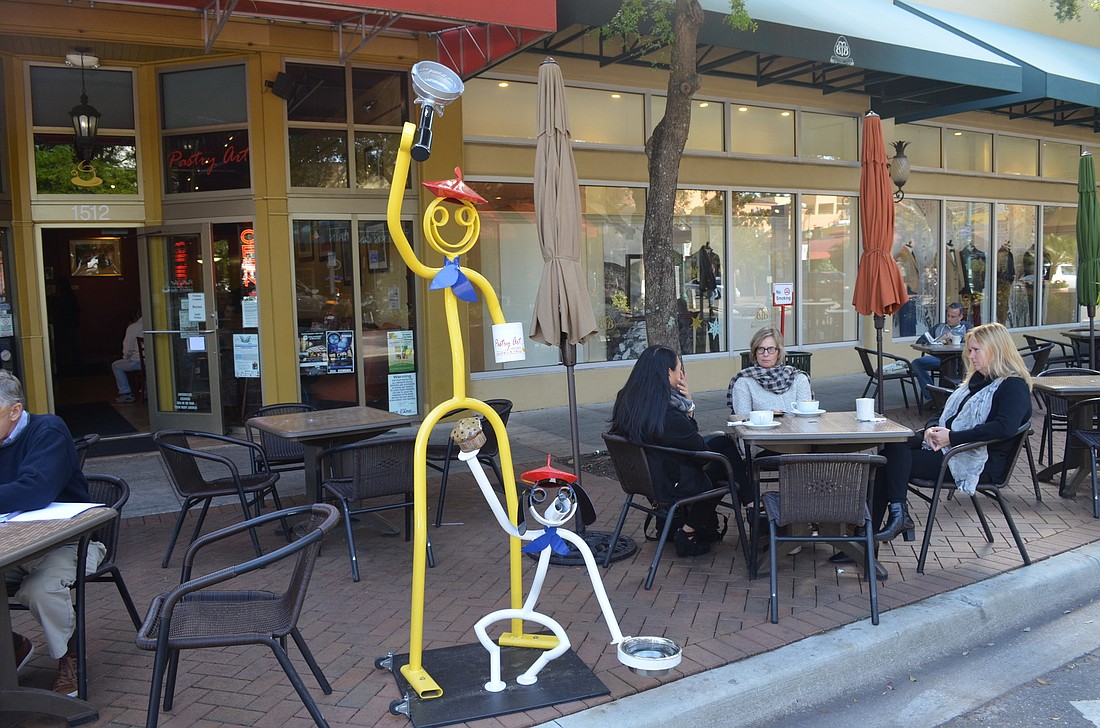- January 2, 2025
-
-
Loading

Loading

The city hopes to cut off an ongoing downtown sign-posting feud at its head, opting for a no-tolerance policy regarding private signs in the right of way.
On Monday, the City Commission voted unanimously to take action against the signs, which were becoming an increasing headache for staff. But the move appears destined to have a more far-reaching impact, with commissioners requesting the removal of all outside items from the public portion of city sidewalks.
Although the precise language of any changes is still forthcoming, the move could affect a variety of objects on city streets.
Those restrictions were a response to an ongoing feud between the Sarasota Downtown Merchants Association, led by Ron Soto, and legal consultant Michael Barfield. The merchants group had posted a series of signs along Main Street discouraging panhandling. Barfield, vice president of the Florida American Civil Liberties Union, objected to the signs’ message and placement, attached by bike lock to city light poles.
Under the existing zoning code, city staff said, the merchants’ signs did not qualify as “signs” — and thus were not restricted from being posted. In response, Barfield began posting a number of provocative signs, criticizing downtown merchants and the anti-panhandling campaign.
Soto, along with other downtown merchants and patrons, responded by cutting down Barfield’s signs. Both parties said law enforcement should reprimand the other. City Attorney Robert Fournier said that, although cutting down the signs could constitute criminal mischief, he didn’t believe anyone should be arrested for such an incident.
Even though the city passively permits the posting of the signs, Fournier added, it doesn’t mean the city is responsible for ensuring those signs remain undisturbed.
Despite the commotion surrounding the right to post opposing signs, Fournier said he believed Barfield’s ultimate goal was to see the anti-panhandling signs removed from the street.
“I think it’s sort of a stunt to make a point,” Fournier said. “And what I think his real objective here is to get rid of the (merchants’) signs.”
Barfield didn’t object to that characterization of his work, stating that he sought to prove a point regarding the city’s definition of signs.
“I have a First Amendment right to prove the absurdity of that position,” Barfield said.
If removing the anti-panhandling messages was his goal, Barfield got his wish: The commission voted 4-1 to tighten its regulations on signs. The city will move to restrict any private signs — as in the dictionary definition, rather than the narrow code definition — from being posted in the right of way.
Soto was upset by the move, arguing that his signs were a good-faith effort to curb an issue downtown and funnel money toward service providers. Through the Sarasota Downtown Merchants Association’s “Downtown Cares” program, businesses gather money for the Salvation Army and other organizations and discouraged direct handouts to panhandlers.
Soto said that Barfield’s issue with the signage was motivated by the effectiveness of the merchants’ efforts.
“The problem he has with these signs is not that Mike wants to exercise his First Amendment right — it’s that the signs actually work,” Soto said. “Panhandling is down to hardly anything.”
When staff brings back an amendment to the code, the new language will also include restrictions on other material stationed in the public right of way. Items mentioned at Monday’s meeting included Tube Dudes and decorated bicycles, such as the flamingo bike local artist Dr. Nik attaches to city signage.
Fournier said that, when he brings the amended regulations back to the board, they will largely focus on private signs, like those posted by Soto and Barfield. Objects, like Tube Dudes and bicycles, are covered by other pars of the code.
So, too, are the A-frame signs many businesses post on the sidewalk. Fournier said those signs are technically supposed to be posted only on private property, though code enforcement has not been stringently enforcing that regulation. When the commission returns to this discussion, that could be an area in need of clarification, Fournier said.
Still, commissioners said they felt the restriction would be the easiest way to assure the issues stemming from the signs would subside, particularly considering Barfield’s litigious reputation.
“This is the cheapest and easiest way to deal with this problem,” Commissioner Shannon Snyder said.
SIGNS OF THE TIMES
The ongoing sign saga began last month, when messages appeared in the heart of the city attacking downtown businesses, like the sign below.

That move, coordinated by Michael Barfield, was in response to a series of merchants’ signs attached to light poles along Main Street discouraging panhandling, as displayed below.
